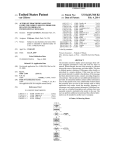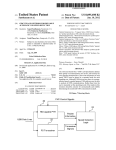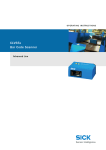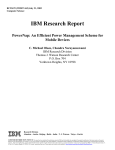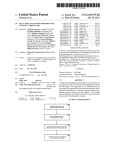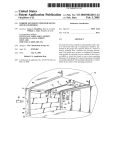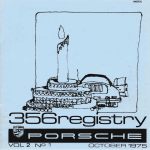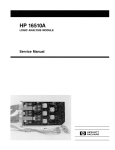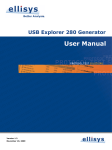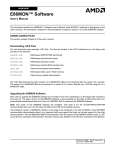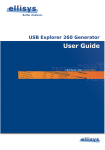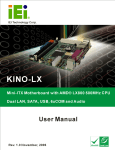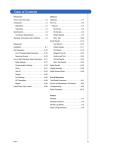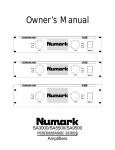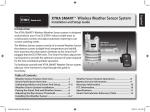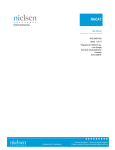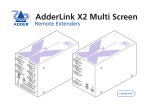Download Methods for analyzing USB data traffic using a single USB host
Transcript
US008176216B1 (12) United States Patent (10) Patent N0.: (45) Date of Patent: Santhanam et a]. (54) (75) Inventors: Gopal Santhanam, Sunnyvale, CA (US); Etai Bruhis, Palo Alto, CA (U S); Kumaran Santhanam, Sunnyvale, CA (Us) Catalyst Enterprises Inc., “USB 1.x/2.0 Analyzer Exerciser Tester,” product speci?cation, entire document relevant. Ellisys, “Ellisys USB Explorer 260 Getting Started Guide,” manual, Nov. 22, 2007, entire document relevant. Ellisys, “Ellisys USB Explorer 200 Getting Started Guide,” manual, Feb. 13, 2006, entire document relevant. Ellisys, “Ellisys USB Tracker 110 Getting Started Guide,” manual, Feb. 13, 2006, entire document relevant. (73) Assignee: Total Phase, Inc., Sunnyvale, CA (US) Notice: May 8, 2012 Catalyst Enterprises Inc ., “Bus & Protocol Analyzers,” product speci ?cation, 2005, entire document relevant. METHODS FOR ANALYZING USB DATA TRAFFIC USINGA SINGLE USB HOST CONTROLLER (*) US 8,176,216 B1 Subject to any disclaimer, the term of this patent is extended or adjusted under 35 USC 154(b) by 226 days. Finisar Corporation, “Bus DoctorTM RX Analyzer,” product speci? cation, entire document relevant. Hitex, “USB Agent Explores the secrets of USB,” brochure, Jun. 2001, entire document relevant. Lecroy Corporation, “LeCroy AdvisorTM USB 2.0 Bus and Protocol Analyzer User Manual,” user manual, Jul. 2007, entire document relevant. (21) Appl.N0.: 12/416,107 Computer Access Technology Corporation, “CATCTM USB ChiefrM (22) Filed: Bus & Protocol Analyzer User’s Manual,” user manual, Nov. 9,2001, entire document relevant. Mar. 31, 2009 Lecroy Corporation, “LeCroy USBMobileHSTM Protocol Analyzer User Manual,” user manual, Jul. 2007, entire document relevant. Related US. Application Data (60) Lecroy Corporation, “LeCroy USBTracerTM USB 2.0 Design &Veri Provisional application No. 61/041,080, ?led on Mar. 31, 2008. ?cation System User Manual,” user manual, Jul. 2007, entire docu ment relevant. Author Unknown, “Universal Serial Bus Speci?cation,” speci?ca tion, Apr. 27, 2000, entire document relevant. (51) Int. Cl. G06F 3/00 (52) US. Cl. ....................................................... .. 710/15 (58) Field of Classi?cation Search ................... .. 710/15 Primary Examiner * Chun-Kuan Lee See application ?le for complete search history. (74) Attorney, Agent, or Firm * Van Pelt, Yi & James LLP (56) (2006.01) * cited by examiner References Cited (57) U.S. PATENT DOCUMENTS 5,787,253 A * 7/1998 6,526,044 B1 * 2/2003 Cookmeyer et al. McCreery et al. .......... .. 709/231 6,615,370 B1* 9/2003 Edwards et al. 7,017,093 B2 * 3/2006 ABSTRACT A method is described for capturing USB data tra?ic for a . 370/352 714/45 Broberg, III ..... .. . 714/724 monitored device by a USB analyzer using a single USB host controller. It comprises the steps of: generating and storing an address and communication speed associated With the USB analyzer; reading a USB packet; discarding selected read OTHER PUBLICATIONS packets based on the stored analyzer address and communi cation speed; and transmitting the remaining packets to an Catalyst Enterprises Inc., “Conquest Series USB Protocol Analyz ers,” product speci?cation, 2006, entire document relevant. 18 Claims, 4 Drawing Sheets 2007/0079288 A1* 4/2007 WillWerth et al. .......... .. 717/124 analysis computer. 30 Plug in Analyzer 32 Enumerate Analyzer Write Data In Buffer Store Anelyzer's Device Address and Analyzai’s Communication Speed D096 the Enable/Disable Filtering No Requesled Device Addvess Match the Analyzer: Address and Do the Speeds Milt-$17 54 Begin Capture 40 Is ?ltering enabled? 56 Is Token PID? Read USB Data No 58 Write date to Buffer is Corrupled PiD? Yes US. Patent May 8,2012 Sheet 1 014 US 8,176,216 B1 US. Patent 2 Ju2 _.52 028: Q m _ 5 .E N, m “ _ O» OF Ow m W “ NH 9 S _ _ _ _ _ _ 7%“_7:"n8§“.Q3E5o2980:iom:r2 May 8,2012 E US 8,176,216 B1 mW EN2mcm < WHw coaw m m W Swamp?‘ m Hw coaw m BZ 3 N IEE5E!“ " f * t ~ 1. . .. 1. . 1 .v v 1., . . .1 1, _ _ _ _ _ _ _ _ Sheet 2 014 n _ _ _ M "“@$829N26bw5mc0m<w u H Mua"E2a2L 3 Z 1_ M"um6@w:2co5a0wm wu H " Ezwvm?av .Jd4;_ d.J_ _ _ _ m 123j_Hm.zE?QCaEvVI,2“._"NP “ N n " [email protected] 2 _ u _ " “ n @wn2co5ma0w m Ew2._P8E5m?é gJ.d;_ u3“528m._9~x32omamc< a 2 LLzh.: “j2_zRm<EemN§E:$ _ _ u n _ 5@"2“M8A?mEz1QgdN?tiEvV M _U?mw W _\L . 3 _ .9“. N E<8F: US. Patent May 8, 2012 US 8,176,216 B1 Sheet 3 of4 Plug in Analyzer i (“32 Enumerate Analyzer Store Analyzer's Device Address and Analyzer’s Communication Speed l (""36 Enable/Disable Filtering l ("38 Begin Capture Yes » ls filtering enabled? Read USB Data l Write data to Buffer Fig. 3a ("44 US. Patent May 8,2012 Sheet 4 014 US 8,176,216 B1 Read USB Data (~50 Write Data to Buffer is it a Token PID? 11 Does the No Requested Device Address Match the Analyzer's Address and Do the Speeds Match? 54 Read USB Data Yes a Is Token P10? is Corrupted PID? Fig. 3!: Yes A US 8,176,216 B1 1 2 METHODS FOR ANALYZING USB DATA TRAFFIC USINGA SINGLE USB HOST CONTROLLER 14 on a single host controller 10. High-speed (HS) commu nication devices are electrically isolated from full-speed (FS) and loW-speed (LS) devices, even if connected to the same host controller. Thus, packets to the analyZer 12 Will only be perceived on the monitor port 15 if the monitor port 15 is HS and the communication port 11 is HS, or if they are both not HS. CROSS REFERENCE This application claims priority from a provisional patent application entitled “Method and Circuits forAnalyZing USB Data Tra?ic Using a Hardware USB Analyzer on a Single USB Host Controller” ?led on Mar. 31, 2008 and having an FIG. 2 illustrates the data tra?ic at various times for an analyZer and a device on the same host controller. Each con 10 application No. 61/041,080. Said application is incorporated herein by reference. nection to the host controller 10 effectively has a logical “Send” and “Receive” unit. All packets sent by the host con troller 10 (see times t0 and t2) are received by all attached FIELD OF INVENTION peripherals (i.e., the device 14 and the analyZer 12). The responses from the peripherals (see times t1 and t3) are only seen on the physical communication interface betWeen the This invention relates to methods for analyzing USB data particular peripheral and the host controller 10. tra?ic, and, in particular, to methods for capturing USB data tra?ic using a USB analyZer on a single USB host controller. BACKGROUND 20 When the host controller 10 sends a packet With the data “PKT2ANL” to the analyZer 12 at time t2, the analyZer 12 receives the packet on its receive logical port (of the commu nication port 11), as Well as on its monitor port 15. Therefore, When the analyZer 12 responds With the monitored data at Universal Serial Bus (USB) is a serial bus standard used for connecting peripheral devices to a host computer. A USB system comprises a USB host, a plurality of doWnstream USB ports, and one or more peripheral devices. A USB host may time t3, that piece of data, “PKT2ANL”, is unnecessarily 25 present in the analyZer response. If the host controller 10 is sending many packets to the analyZer 12, then this has the have multiple USB host controllers (the “host controllers”), potential of overloading the captured analysis traf?c With Wherein each host controller may provide for one or more unnecessary information, and can also take up bandWidth in the analyZer’s response at time t3. USB ports. Speci?cally, the USB 2.0 architecture offers high-speed communications, and is capable of connecting multiple 30 devices to a hub that is further connected to a port of the host computer. The USB 2.0 architecture employs a unidirectional broadcast system. In such a system, When a host controller or hub sends a packet, all devices doWnstream from the origi nating point of the data Will receive the packet. When the host controller communicates With a speci?c device, it must include the address of the device in the Token packet. 35 40 This feature of the USB architecture is especially signi? cant for USB analyZers, Which communicate to an analysis computer through the USB system. FIG. 1 illustrates a typical setup for connecting an analyZer to a USB system, Wherein 45 controller. An analyZer 12 is setup to monitor the communi cations betWeen a host controller 10 and a device 14. The analyZer 12 can be setup such that the host controller 10 and the device 14 are unaWare of the analyZer’s presence on the communication line. Since the analyZer 12 and the device 14 are connected to the same host controller 10, the analyZer 12 Will receive tra?ic (e. g., packet 16) intended for itself and for the device on the communication port 11 and on the monitor port 15. Since packets intended for the communication port 11 of the ana lyZer 12 are also perceived on the monitorport 15, this creates Using a separate host controller for the analysis computer troller, and alloWs both the analyZer and the device under test received by the host controller and hubs that are directly the analyZer and a device are connected to the same host the device address of the analyZer beforehand and set up a ?lter for it. is optimal in all cases; it reduces the load on that host con Upstream tra?ic (i.e., the responses from the devices) is only connected on the return path to the host controller. Previous products and technologies combated this issue in one of tWo Ways: they either avoided the issue entirely by insisting the user put the USB analyZer on a separate host controller, or they required the user of the analyZer to knoW 50 55 to have more available bandWidth. HoWever, this situation is not alWays possible or practical, as it requires the user to include additional hardWare on the analysis computer or to obtain another USB capable computer; thereby requiring a total of tWo computers. Therefore, this requirement excludes users from e?iciently using the analyZer in such a situation, and does not address the problem. Some products give the ability to create a hardWare ?lter that Will serve a similar purpose. The ?lter can be con?gured to discard all data intended for a speci?c device address. In this Way, the analyZer and the device under test can be on the same ho st controller Without overloading the capture buffers. HoWever, these products require the user to knoW the device address of the analyZer in order to con?gure the ?lter. This ?lter Would potentially have to be recon?gured each time the analyZer is used since the device address of the analyZer can change every time it is plugged into a computer. While serv ing a similar purpose to the present invention, this approach a positive feedback loop. Every time the computer requests also puts unnecessary strain on the user to maintain the func data from the analyZer 12, it actually creates more traf?c on the monitorport 15 to be sent back to the computer. The tra?ic tionality of the ?lter. Therefore, it is desirable to provide methods for analyZing can overWhelm the user With unnecessary data and Will also put unnecessary load on the analyZer’ s buffer memory and the 60 controller by automatically ?ltering the USB data tra?ic. analysis computer. This is especially true When the analyZer 12 sends large volumes of analysis data back to the analysis computer simultaneously to When the traf?c is being cap tured. It should be noted that this positive feedback occurs only during particular con?gurations of the analyZer 12 and device USB data tra?ic using a USB analyZer on a single USB host SUMMARY OF INVENTION 65 An object of this invention is to provide methods for rec ogniZing packets received on a monitor port intended for an analyZer’s device address and then discarding those packets. US 8,176,216 B1 3 4 Another object of this invention is to provide methods for analyzing USB data tra?ic Without requiring the analyzer to host controller. Unintentional ?ltering can therefore occur When the analyzer is connected to a HS bus and monitoring be on a separate bus or requiring a manually con?gured ?lter. FS/LS devices on a single host controller, or vice-versa. Yet another object of this invention is to provide methods Therefore the speed of the monitored bus should be checked for an easy and maintainable interface for a user of an ana against the speed of the communication bus. lyzer to automatically ?lter USB traf?c. Brie?y, USB data tra?ic for a monitored device is captured by a USB analyzer, Wherein the monitored device and the USB analyzer utilize only one USB host controller, compris ing the steps of: storing an analyzer address associated With the USB analyzer and the speed of the analyzer’s communi cation port; reading a USB packet; and ?ltering the read For example, if the analyzer’s device address is set to 0x01 and it is communicating at HS, it is possible that a FS device being monitored Will also have a device address of 0x01, even if on the same host controller. If self-?ltering Was enabled, and the speed of the bus Was not taken into account, then the user Would not see any monitored tra?ic (as all packets Would packet as a function of the stored analyzer address and its communication speed. An advantage of this invention is that methods for recog nizing packets received on a monitor port intended for an analyzer’s device address and then discarding those packets are provided. Another advantage of this invention is that methods for analyzing USB data tra?ic Without requiring the analyzer to 20 be on a separate bus or requiring a manually con?gured ?lter are provided. Yet another advantage is that methods for an easy and mechanisms during the capture start-up process. Using this mechanism, users could safely analyze USB maintainable interface for a user of an analyzer to automati cally ?lter USB tra?ic are provided. match that device address and be ?ltered out). Therefore, to aid in this situation the analyzer Would take into account its oWn communication speed and that of the monitored bus. Only if the device address and the speed of communication match Would the packet Would be ?ltered out. The speed of the monitor port Would be detected automati cally through mechanisms not relevant to this invention. The speed of communication port is determined before the cap ture begins. It could therefore be automatically detected by the analyzer, or transmitted to the analyzer through other 25 With a single host controller, even as they test multiple devices of any speed, during a single capture. DESCRIPTION OF THE DRAWINGS FIGS. 3a-3b illustrate a How chart for a preferred embodi ment of the invention for capturing USB data tra?ic for an The foregoing and other objects, aspects, and advantages of the invention Will be better understood from the folloWing detailed description of the preferred embodiment of the analyzer and a device on the same host controller. When an 30 analyzer is connected to a host controller via a USB cable 30, the analyzer is enumerated 32. During the enumeration 32, invention When taken in conjunction With the accompanying draWings in Which: the ho st controller allocates an address to the analyzer in order to prepare for transmission of data to the analyzer and for the FIG. 1 illustrates a typical setup for connecting an analyzer to a USB system, Wherein the analyzer and a device are connected to the same host controller. FIG. 2 illustrates USB data tra?ic at various times for an analyzer and a device connected to the same host controller. FIGS. 3a-3b illustrate a How chart for a preferred embodi 35 ment of the invention for capturing USB data tra?ic for an analyzer and a device connected to the same host controller. 40 reception of data from the analyzer. Upon enumeration of the USB analyzer 32, the analyzer stores its address for future use 34, as Well as its communi cation speed. In an alternative embodiment, the analyzer’s device address does not need to be stored upon enumeration. It can also be determined by the analysis computer, and then transmitted to the analyzer upon starting the capture of USB data traf?c. Similarly, the analyzer’s communication speed DETAILED DESCRIPTION OF THE PREFERRED EMBODIMENTS could be con?gured the same Way. The analyzer can then be con?gured With a single input 45 from the user via a user interface to enable (or disable) the Presently preferred embodiments of the present invention provide methods for effectively monitoring USB data tra?ic ?ltering of packets intended for the analyzer’ s device address on a single USB host controller by implementing a preferably When the capture is started 38, the analyzer checks if the ?ltering of its device address is enabled 40. The analyzer can check if the ?lter is enabled at the beginning of the USB data capture, or, alternatively, it can check Whether the ?lter is enabled at the reception of each packet. If the ?lter is not enabled 40, then the analyzer alloWs all packets through to the rest of the system. The analyzer Will continuously read USB data from the stream 42, Write it to the buffer 44, and check again to see if ?ltering is enabled 40. 36. hardWare based ?lter that removes packets from a monitor port intended for the analyzer. These packets are removed in 50 order to minimize the load on the capture buffers. Further more, a graphical interface for this ?lter is provided to greatly simplify the use of the analyzer. To apply this ?lter, the graphical interface can have a check box to enable this ?lter, a mechanism to call a single function With a single constant in 55 a programming API, or other user interface mechanisms to enable this ?lter. This ?lter can remain valid and functional so If the ?lter is enabled 40, then special ?ltering techniques can be used to remove those packets intended for the analyzer long as the settings are saved, even if the device address of the analyzer changes. In the preferred embodiment of the present invention, the ?ltering mechanism also takes into account the speed of the 60 from the captured data stream. In one example of such special ?ltering techniques, each packet in the USB data tra?ic is read 65 46 to determine Whether it is a Token packet identi?er 48 (herein referred to as a “Token PID”). If it is not a Token PID 48, or it is a Token PID that does not match the analyzer’s device address 52 or if the speed does not match, then the analyzer Writes the data to an outbound buffer 50, and reads monitored bus. The USB protocol is de?ned in such a Way that on a single host controller the device address space (meaning the set of possible device addresses) of full-speed (FS) and loW-speed (LS) communication is separate to that of high-speed (HS). Therefore, it is possible for HS devices to have the same device address of FS or LS devices on the same the next piece of USB data 40. In comparing the speed of the communication port and the monitor port, they are considered US 8,176,216 B1 6 5 address that is equal to the stored analyzer address, and matched if the communication port is HS and the monitor port is HS, or if the communication port is not HS and the monitor port is not HS. However, if the packet is a Token PID 48 that matches the analyzer’s device address 52 and the communication speed of the analyzer, then the analyzer does not Write that data to the Whether a ?rst communication speed associated With the monitored device matches With a second communica tion speed associated With the USB analyzer. 2. The method of claim 1 further comprising the step of: transmitting the ?ltered USB packet to an analysis computer. 3. The method of claim 1 Wherein the monitored device and the USB analyzer utilize the same USB host controller. 4. The method of claim 3 Wherein in the ?ltering step, outbound buffer. Instead, it transitions to a neW state and reads the next piece of USB data 54. Once in this neW state, the analyzer Will not Write any of the neW USB data into the buffer until a neW Token PID is received that does not match the further comprising the substep: analyzer’s device address (since all interim non-Token pack if the USB packet is a token packet identi?er and if the token packet identi?er has a target address not equaling ets are taken to be intended for the analyzer). After the next piece of USB data is read, the analyzer to the analyzer address, storing the USB packet. determines Whether the read USB data is a Token PID 56. If the data is a Token PID, then the requested device address in the Token PID is compared to the analyzer’s address and speed to determine if the addresses match 52. If the addresses and speed do not match, then the data is Written to the buffer 50. If the addresses and speed match, the analyzer does not Write that data to the outbound buffer, and the next USB data is read 54. If the read USB data is not a Token PID, then it is deter mined Whether the data is a corrupted PID 58. If the data is a corrupted PID, then the data is Written to the buffer 50. If the data is not a corrupted PID, then the next USB data is read 54. In an alternative embodiment, the analyzer can ?lter only a 5. The method of claim 3 Wherein in the ?ltering step, further comprising the substep: if the USB packet is a token packet identi?er and if the token packet identi?er has a target address equaling to the analyzer address, discarding the USB packet. 20 the USB packet is a corrupted packet identi?er, storing the USB packet. 7. The method of claim 3 Wherein the USB analyzer has a pass-through buffer and if a token packet identi?er has a 25 subset of packets (e.g., those packets only matching certain 8. The method of claim 3 Wherein a graphical user interface is provided for enabling or disabling the ?ltering step. 30 to the device can be seen on the analysis computer and ana lyzed. As a general case, data to the analyzer itself Would be ?ltered out; and, as an option, tra?ic to the analyzer can also be transmitted to the analysis computer if so desired. It is important to note that other products and technologies employ display ?lters to aid With the visualization of the data. This is not to be confused With the type of ?ltering presented by this invention. Display ?ltcrs Work only on already cap tured data, and only ?lter What has already been doWnloaded to the analysis computer. This invention ?lters the packets 35 40 before they reach the capture buffer; thus, reducing the hard 45 While the present invention has been described With refer ence to certain preferred embodiments or methods, it is to be understood that the present invention is not limited to such speci?c embodiments or methods. Rather, it is the inventor’s contention that the invention be understood and construed in 50 its broadest meaning as re?ected by the folloWing claims. Thus, these claims are to be understood as incorporating not only the preferred methods described herein but all those other and further alterations and modi?cations as Would be apparent to those ordinary skilled in the art. We claim: 1. A method for capturing universal serial bus (USB) data tra?ic for a monitored device by a USB analyzer, comprising the steps of: 55 generating and storing an analyzer address associated With the USB analyzer, Wherein the storing of the analyzer address is performed automatically upon enumeration of the USB analyzer; reading a USB packet; and ?ltering the read USB packet at least in part based on Whether the read USB packet is a token packet identi?er, 60 and Whether the token packet identi?er has a target 9. The method of claim 3 Wherein in the ?ltering step, ?ltering is performed as a function of the packet type of the read USB packet. 10. The method of claim 1, Wherein ?ltering comprises: if the USB packet is a token packet identi?er, and if the token packet identi?er has a target address that is equal to the stored analyzer address, and if the ?rst communi cation speed associated With the monitored device matches With the second communication speed associ ated With the USB analyzer, entering a state in Which one or more subsequent read USB packets are discarded. 11. The method of claim 10, Wherein the state is exited in the event that a neW token packet identi?er is received and that the neW token packet identi?er has a target address that is not Ware buffer usage, the load on the analysis computer, and the intrusiveness of the analyzer. Display ?lters cannot prevent the capture buffer from being overloaded and exhausted by the unnecessary tra?ic described previously. target address not equaling to the analyzer address, the USB packet is stored in the pass-through buffer of the USB ana lyzer. packet types) intended for its device address. The data in the buffer is then transmitted to the analysis computer via the host controller and thereby the USB tra?ic 6. The method of claim 4 Wherein in the ?ltering substep, if equal to the stored analyzer address. 12. A method for capturing universal serial bus (USB) data traf?c for a monitored device by a USB analyzer, comprising the steps of: generating and storing an analyzer address associated With the USB analyzer, Wherein the storing of the analyzer address is performed automatically upon enumeration of the USB analyzer; reading a USB packet; ?ltering the read USB packet at least in part based on Whether the read USB packet is a token packet identi?er, and Whether the token packet identi?er has a target address that is equal to the stored analyzer address, and Whether a ?rst communication speed associated With the monitored device matches With a second communica tion speed associated With the USB analyzer; and transmitting the ?ltered USB packet to an analysis com puter. 13. The method of claim 12 Wherein in the ?ltering step, further comprising the substep: 65 if the USB packet is a token packet identi?er and if the token packet identi?er has a target address not equaling to the analyzer address, storing the USB packet. US 8,176,216 B1 8 7 14. The method of claim 13 wherein in the ?ltering substep, if the USB packet is a corrupted packet identi?er, storing the generate and store an analyZer address associated With the USB analyZer, Wherein the storing of the analyZer address is performed automatically upon enumera tion of the USB analyzer; USB packet. 15. The method of claim 12 Wherein the USB analyzer has read a USB packet; and ?lter the read USB packet at least in part based on Whether the read USB packet is a token packet iden ti?er, and Whether the token packet identi?er has a a pass-through buffer and if a token packet identi?er has a target address not equaling to the analyZer address, the USB packet is stored in the pass-through buffer of the USB ana lyZer. target address that is equal to the stored analyZer address, and Whether a ?rst communication speed 16. The method of claim 12 Wherein in the storing step, the analyZer address is assigned by the analysis computer having associated With the monitored device matches With a a USB host controller. second communication speed associated With the USB analyZer; and 17. The method of claim 16 Wherein the monitored device and the USB analyZer utiliZe the same USB host controller. 18. A USB analyZer for capturing universal serial bus (USB) data traf?c for a monitored device, comprising: a processor con?gured to: 15 a memory coupled to the processor and con?gured to pro vide the processor With instructions. * * * * *









